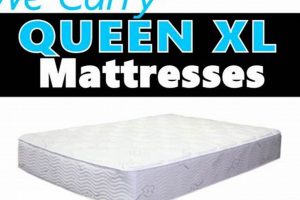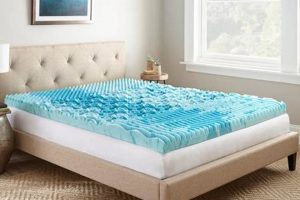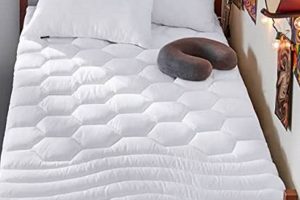The monetary outlay required to acquire a twin extra-long mattress represents a significant consideration for consumers, particularly students and individuals with limited living space. This figure can vary substantially depending on factors such as mattress type (e.g., innerspring, memory foam, hybrid), brand reputation, material quality, and retailer markups. For instance, a basic innerspring model might have a lower price point compared to a high-end memory foam option featuring advanced cooling technology.
Understanding the factors influencing this expense allows for informed decision-making. Selecting a mattress that balances comfort, support, and longevity with budgetary constraints is paramount. Historically, mattress prices have been influenced by manufacturing advancements, material sourcing, and evolving consumer preferences for enhanced sleep solutions.
The following sections will delve deeper into specific price ranges, discuss strategies for finding affordable options, and explore the long-term value proposition associated with different mattress choices.
Strategies for Managing Twin XL Mattress Expenditure
Effective management of the expenditure associated with a twin XL mattress requires careful planning and diligent comparison. The following tips provide a framework for securing a suitable mattress within a defined budget.
Tip 1: Conduct Thorough Market Research: Compare offerings from multiple retailers, both online and brick-and-mortar. Note variations in price, warranty, and return policies.
Tip 2: Identify Sales and Promotional Periods: Mattress retailers frequently offer discounts during holidays such as Memorial Day, Labor Day, and Black Friday. Timing a purchase to coincide with these periods can yield substantial savings.
Tip 3: Explore Direct-to-Consumer Brands: Companies that bypass traditional retail channels often offer competitive pricing due to reduced overhead costs.
Tip 4: Consider Certified Pre-Owned or Refurbished Options: Some retailers offer mattresses that have been inspected and reconditioned. These may provide significant discounts compared to new models. Ensure the retailer has a robust sanitation process.
Tip 5: Negotiate with Retailers: Do not hesitate to negotiate the price, especially at brick-and-mortar stores. Retailers may be willing to match competitor pricing or offer additional discounts.
Tip 6: Factor in Shipping and Return Costs: When purchasing online, consider shipping fees and return policies. A seemingly low price may be offset by high shipping charges or restrictive return conditions.
Tip 7: Read Customer Reviews: Before committing to a purchase, review customer feedback to gauge the mattress’s quality, durability, and overall satisfaction. This can help avoid costly mistakes.
Applying these strategies can lead to a more informed and cost-effective purchase, ensuring the acquisition of a suitable twin XL mattress without exceeding budgetary constraints.
The subsequent sections will explore the long-term implications of mattress selection, focusing on durability and the potential for future replacement expenditures.
1. Material Composition
The material composition of a twin XL mattress is a primary determinant of its ultimate acquisition expenditure. The specific materials utilized directly impact manufacturing processes, performance characteristics, and projected lifespan, thereby influencing the final retail price.
- Foam Density and Type
Higher density foams, such as memory foam or latex, typically command a higher price due to increased material cost and enhanced support and pressure relief capabilities. Conversely, lower-density polyurethane foams are more economical but may exhibit reduced durability and comfort levels. For example, a high-density memory foam mattress core will contribute significantly to the overall twin XL mattress cost compared to a standard polyurethane foam core.
- Innerspring Coil Count and Gauge
For innerspring mattresses, the coil count and gauge (thickness) of the coils influence the support and resilience of the mattress. Higher coil counts and lower gauge (thicker) coils translate to increased material usage and manufacturing complexity, resulting in a higher twin XL mattress cost. A mattress with individually wrapped coils also tends to be more expensive than one with interconnected coils.
- Cover Fabric Quality
The type and quality of fabric used for the mattress cover contributes to both comfort and price. Materials like organic cotton, wool, or specialized performance fabrics designed for breathability and moisture-wicking are more expensive than standard polyester blends. The use of higher quality fabric directly increases the twin XL mattress cost.
- Additional Comfort Layers
The incorporation of additional comfort layers, such as gel-infused memory foam, cooling gel beads, or specialized fiber blends, adds to the overall material cost. These features aim to enhance sleep quality and address specific comfort needs but inevitably increase the final twin XL mattress cost.
The interplay between these material factors dictates the final market expense of the twin XL mattress. Selections prioritizing premium materials and advanced construction techniques will invariably incur a greater cost, reflecting their enhanced performance and expected longevity.
2. Brand Reputation and Twin XL Mattress Cost
Brand reputation significantly influences the acquisition expenditure associated with a twin XL mattress. Established brands often command a premium due to perceived quality, reliability, and customer service. This premium reflects years of investment in research and development, marketing, and building customer trust. Consumers may be willing to pay a higher price for a mattress from a well-known brand, anticipating a superior sleep experience and reduced risk of premature product failure. The cause-and-effect relationship is evident: a positive brand image fosters customer loyalty and willingness to invest more. The importance of brand reputation as a component of the overall investment should not be overlooked.
For example, consider two twin XL mattresses with similar specifications: one from a lesser-known brand and another from a nationally recognized brand with a history of positive reviews. The latter is likely to have a higher price point, even if the materials and construction are comparable. This difference accounts for the inherent value placed on the brand’s name and its associated reputation. Another example is a brand with a proven record of eco-friendly manufacturing processes and sustainable materials might attract environmentally conscious consumers willing to pay more. This illustrates the practical significance of brand perception in determining the final purchase price.
In summary, brand reputation serves as a critical factor influencing the overall expenditure on a twin XL mattress. While other factors, such as material composition and retailer markups, also contribute, the intangible value of a respected brand can significantly elevate the product’s financial investment. Understanding this relationship enables consumers to make more informed decisions, weighing the perceived benefits of a reputable brand against their budgetary considerations. A challenge remains in objectively quantifying the ‘value’ of a brand, underscoring the need for careful comparison of specifications, warranties, and customer feedback in conjunction with brand recognition.
3. Retailer markup
Retailer markup is a significant determinant of the ultimate expenditure associated with a twin XL mattress. This markup represents the difference between the cost a retailer pays for the mattress from the manufacturer and the price at which it is offered to consumers. This difference covers operational expenses, including rent, utilities, employee salaries, marketing costs, and profit margins. Consequently, the retailer markup exerts a direct and substantial influence on the final twin XL mattress cost. This effect is causal: higher markups translate to a higher price, and vice versa. Understanding the magnitude and variability of these markups is critical for consumers seeking to optimize their purchasing decisions.
The practical significance of understanding retailer markup lies in the ability to compare prices across different retailers and discern potential negotiation opportunities. For instance, a mattress priced at $500 at one store might be available for $450 at another, due to differing markup strategies. Consumers armed with this knowledge can strategically target retailers known for lower markups or leverage competitive pricing to negotiate better deals. Direct-to-consumer brands, which often bypass traditional retail channels, may offer lower prices due to reduced overhead costs. Furthermore, promotional periods and sales events can significantly compress retailer markups, presenting opportune moments for cost-effective purchases.
In summary, retailer markup is an integral component of the twin XL mattress cost. Its influence is pervasive and directly affects the affordability of these mattresses. While other factors, such as material composition and brand reputation, also contribute to the overall expense, the retailer’s pricing strategy remains a key consideration for budget-conscious consumers. The challenge lies in accurately determining the actual markup applied by each retailer, which is often opaque. However, diligent price comparison and strategic timing of purchases can mitigate the impact of retailer markups on the final twin XL mattress cost.
4. Mattress Technology
Advances in mattress technology exert a direct influence on the acquisition expenditure associated with twin XL mattresses. The incorporation of innovative features designed to enhance sleep quality, support, and durability often translates into higher manufacturing costs, which are subsequently reflected in the retail price. Complex construction techniques, specialized materials, and integrated functionalities all contribute to the overall twin XL mattress cost. For example, a twin XL mattress featuring zoned support, where different sections of the mattress provide varying levels of firmness, requires more intricate manufacturing processes and potentially more expensive materials than a standard mattress with uniform support. This direct causal link between technology and cost necessitates a nuanced understanding of the specific features and their perceived benefits.
The practical significance of understanding the relationship between mattress technology and expense lies in the ability to critically evaluate the value proposition of different features. Consider a mattress with advanced cooling technology, such as gel-infused memory foam or breathable fabrics. While these features may offer enhanced comfort, their inclusion will invariably increase the twin XL mattress cost. Consumers must weigh the benefits of these technologies against their budgetary constraints and individual preferences. For instance, an individual who sleeps hot might find the investment in cooling technology worthwhile, whereas someone who sleeps at a comfortable temperature may not perceive the added expense as justified. Similarly, a mattress incorporating smart technology, such as sleep tracking and adjustable firmness settings, will command a significantly higher price than a traditional mattress. The utility of these features depends on the individual’s needs and willingness to pay for them.
In summary, mattress technology plays a crucial role in determining the overall expenditure on a twin XL mattress. Innovations designed to improve sleep quality and functionality often come at a premium. Consumers must carefully assess the specific technologies incorporated into a mattress and weigh their benefits against their budgetary considerations. While advanced features may offer enhanced comfort and performance, they invariably contribute to a higher twin XL mattress cost. The challenge for consumers is to discern which technologies are genuinely valuable and which are simply marketing gimmicks, requiring thorough research and careful comparison of different mattress options.
5. Warranty coverage
Warranty coverage is a significant component in the overall expenditure associated with a twin XL mattress. The length and comprehensiveness of the warranty directly influence the perceived value and, consequently, the retail price of the mattress. A more extensive warranty typically indicates a manufacturer’s confidence in the product’s durability and longevity, potentially justifying a higher initial investment. This facet of the purchase contributes to the overall life cycle assessment of the mattress.
- Warranty Duration and Twin XL Mattress Cost
A longer warranty period, such as ten years or more, often correlates with a higher mattress price. Manufacturers factor the potential costs of warranty claims into the initial pricing. For example, a twin XL mattress with a 20-year warranty from a reputable brand will typically cost more than a comparable mattress with a 5-year warranty. This premium reflects the increased financial risk assumed by the manufacturer.
- Scope of Coverage
The specific defects covered by the warranty significantly impact its value and the mattress expenditure. A warranty that covers a wide range of issues, such as sagging, indentations, and manufacturing defects, is more valuable and may contribute to a higher price. Conversely, a limited warranty that only covers specific defects may result in a lower upfront cost, but it also exposes the consumer to greater financial risk in the event of unforeseen problems. For example, a warranty that excludes body impressions less than 1.5 inches deep may not be as valuable as one that covers all indentations exceeding a certain threshold.
- Pro-rated vs. Non-pro-rated Warranties
The type of warranty, whether pro-rated or non-pro-rated, affects the total investment. A non-pro-rated warranty provides full replacement or repair for covered defects within the warranty period, whereas a pro-rated warranty requires the consumer to pay a portion of the replacement cost based on the age of the mattress. Non-pro-rated warranties typically contribute to a higher initial twin XL mattress cost due to the manufacturer’s greater financial liability. A pro-rated warranty may offer a lower upfront cost but can result in unexpected expenses later in the mattress’s lifespan.
- Transferability of Warranty
The transferability of the warranty can influence the perceived value and, indirectly, the mattress expenditure. A transferable warranty, which allows the original purchaser to transfer the warranty to a subsequent owner, may enhance the resale value of the mattress and justify a higher initial price. Conversely, a non-transferable warranty limits the benefits to the original purchaser and may have a less pronounced impact on the twin XL mattress cost.
In conclusion, warranty coverage is an integral facet of the total twin XL mattress cost. The duration, scope, type, and transferability of the warranty all contribute to the perceived value and, ultimately, the price of the mattress. Consumers must carefully evaluate the warranty terms and conditions to determine whether the added expenditure is justified by the enhanced protection and peace of mind offered by comprehensive warranty coverage. A thorough examination of warranty details, combined with considerations of material composition, brand reputation, and retailer markup, allows for informed decision-making and optimal expenditure on a twin XL mattress.
Frequently Asked Questions
This section addresses common inquiries regarding the financial outlay associated with acquiring a twin XL mattress. It aims to provide clarity on factors influencing pricing and assist consumers in making informed purchasing decisions.
Question 1: What constitutes a reasonable expenditure for a twin XL mattress?
A reasonable expenditure is contingent upon individual budgetary constraints, desired material quality, and brand preferences. Budget-conscious consumers may find suitable options within the $150-$300 range, while those prioritizing premium materials and advanced features may encounter prices exceeding $500. It is imperative to establish a predetermined budget prior to commencing the purchasing process.
Question 2: Do online retailers consistently offer lower prices compared to brick-and-mortar stores?
Online retailers frequently provide competitive pricing due to reduced overhead expenses associated with physical storefronts. However, it is crucial to account for potential shipping costs and the absence of a tactile evaluation opportunity prior to purchase. Brick-and-mortar stores permit firsthand assessment but may incorporate higher markup margins to offset operational costs.
Question 3: How significantly do mattress materials influence the overall expenditure?
Material composition exerts a profound influence on the overall expenditure. Mattresses constructed from high-density memory foam, natural latex, or incorporating advanced cooling technologies typically command a higher price point compared to those utilizing conventional innerspring systems or polyurethane foams. The selection of materials directly affects both the comfort level and the anticipated lifespan of the mattress.
Question 4: Are extended warranties a worthwhile investment?
The value of an extended warranty is subjective and depends on individual risk tolerance and the perceived durability of the chosen mattress. While an extended warranty offers protection against certain defects or premature wear, it also represents an additional expenditure. A thorough review of the warranty terms and conditions is crucial to determine the scope of coverage and any potential limitations.
Question 5: Do seasonal sales events genuinely offer substantial savings?
Seasonal sales events, such as Memorial Day, Labor Day, and Black Friday, often present opportunities for significant cost savings. Retailers frequently offer discounted pricing and promotional incentives during these periods to stimulate sales volume. Diligent price comparison and strategic timing of purchases can yield substantial reductions in the overall expenditure.
Question 6: Is it advisable to consider refurbished or pre-owned twin XL mattresses?
Refurbished or pre-owned mattresses may offer significant cost savings. However, it is imperative to ensure that the retailer adheres to stringent sanitation protocols and provides a reasonable warranty. Potential drawbacks include reduced lifespan and potential exposure to allergens or pathogens. Thorough inspection and verification of the retailer’s refurbishment processes are essential.
Careful consideration of these factors can assist in navigating the complexities of twin XL mattress pricing. Further research into specific brands and models is encouraged to ensure a purchase aligned with individual requirements and financial parameters.
The subsequent sections will explore considerations for maintaining and extending the life of a twin XL mattress.
Twin XL Mattress Cost
The preceding analysis has explored the multifaceted dimensions of twin XL mattress cost. Key determinants identified include material composition, brand reputation, retailer markup, mattress technology, and warranty coverage. Understanding these factors empowers consumers to navigate the market more effectively, balancing budgetary constraints with desired features and longevity. The information presented underscores the significance of thorough research and strategic purchasing decisions.
Given the substantial investment involved, continued diligence in evaluating mattress options is essential. Consumers are encouraged to utilize the information provided to make well-informed decisions that prioritize both comfort and value. The long-term implications of mattress selection, encompassing health and sleep quality, warrant careful consideration beyond the immediate financial outlay.







